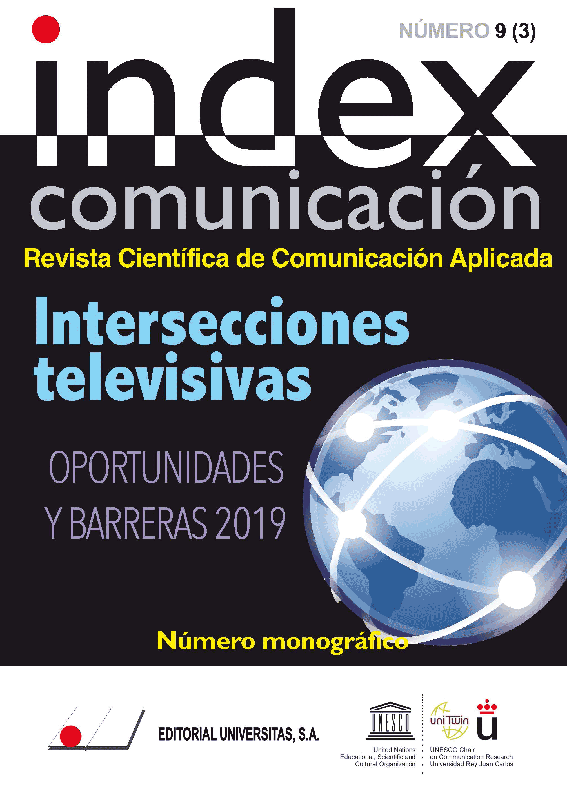Go Big or Go Home! The AT&T-Time Warner Vertical Merger
DOI:
https://doi.org/10.33732/ixc/09/03GobigoKeywords:
Vertical Integration, Digital Convergence, TV Industry,Abstract
In this paper we analyze the vertical merger between the telecommunications company AT&T and the media conglomerate Time Warner as a result of the changes in the American TV industry, caused by digital convergence. From a theoretical-methodological perspective of political economy of communication, we examine the anti-competitive effects of the merger on the market and its possible consequences. This analytical input allows us to consider the new conditions in which video content is produced, distributed and consumed as a result of digitization.Metrics
References
BODKIN, J. (2019, marzo 12). AT&T raises DirecTV Now price again after promising lower post-merger bills. Arstechnica. Recuperado de: https://arstechnica.com/ information-technology/2019/03/att-raises-directv-now-price-again-after-promising- lower-post-merger-bills/
CHEN, J. y STALLAERT, J. (2014). An Economic Analysis of Online Advertising Using Behavioral Targeting. MIS Quarterly, 38(2), 429-449. Recuperado de: https://ssrn.com/abstract=1787608
Complaint, United States v. AT&T Inc. (2017), No. 1:17-cv-02511
Recuperado de: https://www.justice.gov/atr/case-document/file/1012916/download
DASTIN, J. (2018, marzo 15). Exclusive: Amazon's internal numbers on Prime Video, revealed. Reuters. Recuperado de: https://www.reuters.com/article/us-amazon-com- ratings-exclusive/exclusive-amazons-internal-numbers-on-prime-video-revealed- idUSKCN1GR0FX
EISENACH, J. y WATTS, T. (2017). Effects of the AT&T-Time Warner Transaction on Competition in the Premium Channels Industry. White Paper for the U.S. Department of Justice. The Washington Post.
Federal Communication Commission (2017). 18th Annual Video Competition Report. Recuperado de: https://docs.fcc.gov/public/attachments/DA-17-71A1.pdf
GROSSMAN, S. y Hart, O. (1986). The Costs and Benefits of Ownership: A Theory of Vertical Integration. Journal of Political Economy, 94, 691-719.
HOVENKAMP, H. (2008). The antitrust enterprise: principle and execution. Cambridge, Massachusetts: Harvard University Press.
HOVENKAMP, H. (2017). Principles of Antitrust. St. Paul, MN: West Academic Publishing.
JENSEN, M. y MECKLING, W. (1976). Theory of the Firm: Managerial Behavior, Agency Costs, and Ownership Structure. Journal of Financial Economics, 3, 305-360.
LERNER, A. (2014). The Role of 'Big Data' in Online Platform Competition. SSRN. Recuperado de: https://ssrn.com/abstract=2482780
MAYER, J. (2019, marzo 11). The Making of the Fox News White House. The New Yorker. Recuperado de: https://www.newyorker.com/magazine/2019/03/11/the-making-of-the-fox-news-white-house
MEIKLE, G. y YOUNG, S. (2011). Media convergence: Networked digital media in everyday life. Basingstoke: Palgrave Macmillan.
MILLER, V. (2011). Understanding digital culture. London, Thousand Oaks: Sage.
PATTEN, D. (2018, diciembre 13). Netflix, Amazon, Hulu & Apple Top TV for 1st Time; Broadcast & Cable Decline. Deadline.com. Recuperado de: https://deadline.com/2018/12/streaming-series-surpass-cable-broadcast-first-time-fx-study-1202519711/
PEIL, C. y SPARVIERO, S. (2017). Media Convergence Meets Deconvergence. En SPARVIERO, S. et al. (eds.). Media Convergence and Deconvergence, Global Transformations in Media and Communication Research. A Palgrave and IAMCR Series.
Proposed conclusions of Law of the United States, United States v. AT&T Inc., No. 1:17- cv-02511 at 20-21 (D. D.C. Aug. 5, 2018).
Recuperado de: https://www.justice.gov/atr/case-document/file/1061066/download
RIORDAN, M. y SALOP, S. (1995). Evaluating vertical mergers: a post-Chicago approach. Antitrust Law Journal, 513-541.
RIORDAN, M. (2008). Competitive Effects of Vertical Integration. En Handbook of Antitrust Economics. Washington, DC: Paolo Buccirossi ed.
SALOP, S. y CULLEY, D. (2016). Revising the US Vertical Merger Guidelines: Policy Issues and an Interim Guide for Practitioners. Journal of Antitrust Enforcement, 1-41.
SHAPIRO, C. y VARIAN, H. (1999). Information rules: a strategic guide to the network economy. Boston, Massachusetts: Harvard Business School Press.
SHAPIRO, C. (2010). The 2010 Horizontal Merger Guidelines: From Hedgehog to Fox in Forty Years. SSRN. Recuperado de: https://ssrn.com/abstract=1675210
SHAPIRO, C. (2018). Expert report. United States v. AT&T Inc., DirecTV Group Holdings, LLC, and Time Warner Inc. Antitrust Division. Department of Justice. Recuperado de: https://www.justice.gov/atr/casedocument/file/1081336/download
Trial brief of the United States, United States v. AT&T Inc. (2018), No. 1:17-cv-02511. Recuperado: https://www.justice.gov/atr/casedocument/file/1042996/download
United States v. AT&T Inc. (2018), Civil Case No. 17-2511. Recuperado de:
https://es.scribd.com/document/381649278/ATTDecision#download&from_embed
WU, T. (2018). The Curse of Bigness Antitrust in the New Gilded Age. Nueva York: Columbia Global Reports.
YOO, C. (2002). Vertical Integration and Media Regulation in the New Economy. Yale Journal on Regulation. Vol. 19 (1).
Recuperado de: http://digitalcommons.law.yale.edu/yjreg/vol19/iss1/5
Published
How to Cite
Issue
Section
License
Copyright (c) 2019 Serguei Komissarov, Emiliano Sánchez Narvarte

This work is licensed under a Creative Commons Attribution-NonCommercial 4.0 International License.
Authors who submit to this journal agree to the following terms:
Authors retain copyright and ensure the magazine's right to be the first publication of the work as licensed under a Creative Commons Attribution-NoComercial 4.0 International License that allows others to share the work with an acknowledgment of authorship of the work and the initial publication in this magazine, with no commercial purpose.
Authors can establish separate additional agreements for non-exclusive distribution of the version of the work published in the magazine (for example, to an institutional repository or publish it in a book), with an acknowledgment of its initial publication in this journal.
It allows and authors are encouraged to disseminate their work electronically (eg, in institutional repositories or on their own website) prior to and during the submission process, as it can lead to productive exchanges, as well as a citation more early and most of the published work (See The Effect of Open Access).















